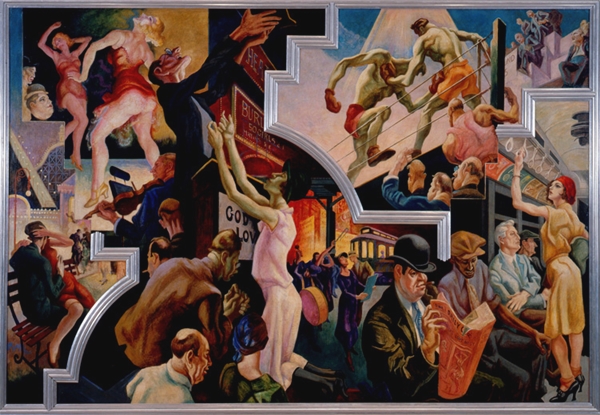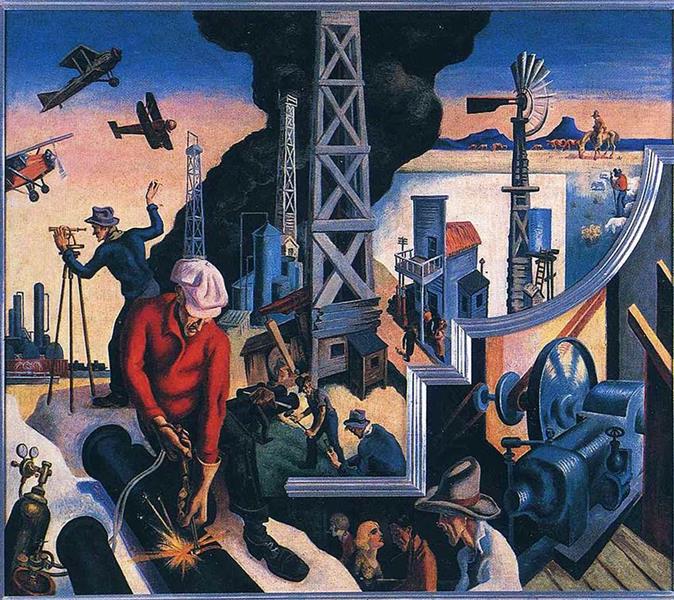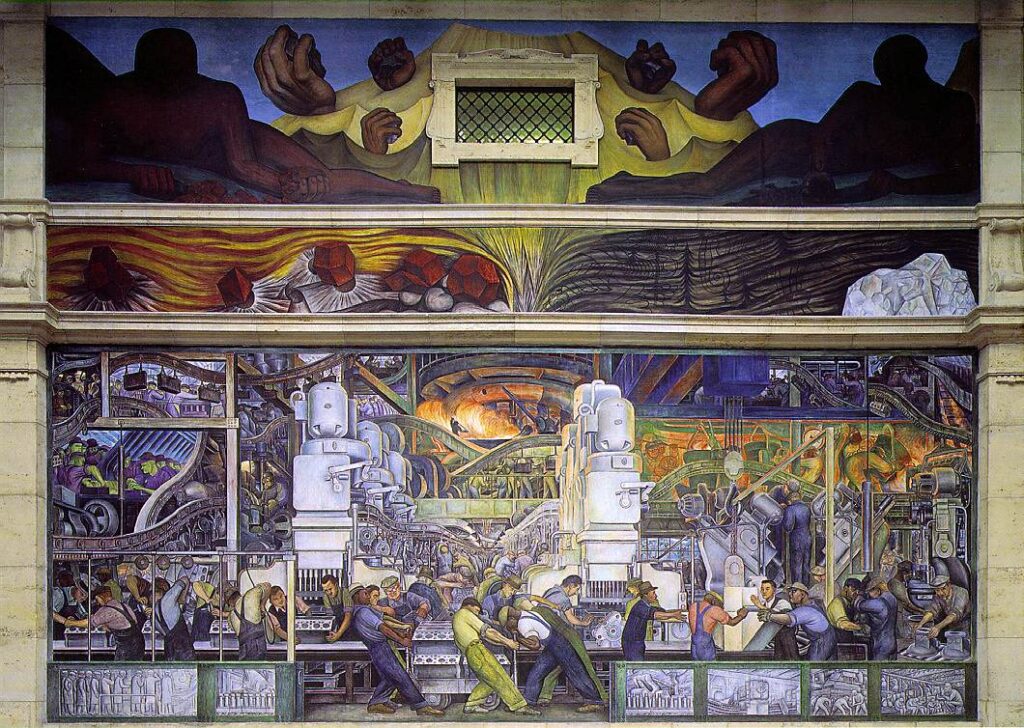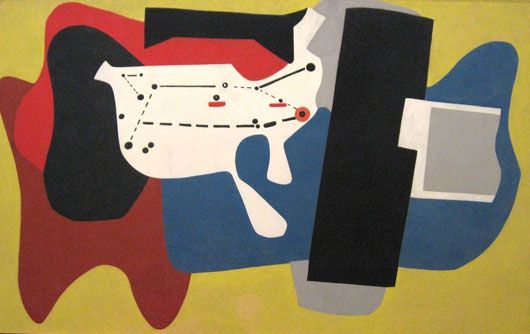
The Importance of the Works Projects Administration
Federal government-aided programs have been a large financial support of the arts, but they rarely help shape the course of art history as much as the Works Projects Administration that ran between 1935-43.
The New Deal initiative was an executive order by President Franklin D. Roosevelt that included the WPA.
The Works Projects Administration was an American agency intended to aid in creating jobs and infrastructure for millions of Americans during the Great Depression.
It employed millions of Americans for various jobs, including construction projects, but most notably artists to carry out public works projects. This included painting murals of public buildings and public art projects.
Within the WPA was the Federal Project Number One initiative, which employed musicians, artists, writers, actors and directors in arts, drama, media and literary projects. The five projects dedicated to these were the Federal Writer’s Project (FWP), the Historical Records Survey (HRS), the Federal Theatre Project (FTP), and most notably for the course of art history, the Federal Art Project (FAP).
The Federal Art Project

The Federal Art Project was the visual arts arm of Federal Project Number One, a program of the Works Projects Administration intended to employ struggling artists during the Great Depression.
Funded under the Emergency Relief Appropriation Act of 1935, it operated from August 29, 1935, until June 30, 1943.
It was created as a relief measure to employ artists and artisans to create murals, easel paintings, sculptures, graphic art, posters, photographs, Index of American Design documentation, museum and theater scenic design, and arts and crafts.
The Federal Art Project operated community art centers throughout the country where craft workers and artists worked, exhibited and educated others. The project created more than 200,000 separate works, some of which remained among the country’s most significant pieces of public art and forged some of the most significant art movements in American art history.
What Was the Purpose of the Federal Art Project?
The Federal Art Project’s primary goals were to employ out-of-work artists and to provide art for non federal municipal buildings and public spaces. Artists were paid $23.60 a week, and tax-supported institutions such as schools, hospitals and public buildings paid only for materials.
The work was divided into art production, art instruction and art research. The primary output of the art-research group was the Index of American Design, a mammoth and comprehensive study of American material culture that can be found today in the Library of Congress.
What Are Some of the Projects of the Works Projects Administration?

As many as 10,000 artists were commissioned to produce work for the WPA’s Federal Art Project, the largest of the New Deal art projects.
Three comparable but distinctly separate New Deal art projects were administered by the United States Department of the Treasury: the Public Works of Art Project (1933–1934), the Section of Painting and Sculpture (1934–1943) and the Treasury Relief Art Project (1935–1938).
Public Works of Art Project
The PWAP served as a way to employ artists while having competent representatives of the profession display their work in a public setting.
Although the program lasted less than one year, it employed 3,749 artists, who produced 15,663 works of art.
The PWAP sought to produce images focused on the “American Scene”, and commissioned paintings and murals that depicted optimistic visions of America during a time of economic desperation. However, many artists disliked the idea of creating art that focused only on the positive aspects of living in America, as people were still experiencing dire hardships and personal tragedies from the Great Depression.
This created a community of PWAP artists who aspired to create artworks depicting both sides of America and were referred to as Social Realists.
Section of Painting and Sculpture
The Section’s main function was to select high-quality art to decorate public buildings in the form of murals, making art accessible to all people. Because everyone usually visited post offices, they were the places selected to display these projects.
Unlike the other New Deal art programs, the Section awarded commissions through competitions and paid artists a lump sum for their work. Competitions were open to all artists, regardless of economic status, and artists’ proposals were reviewed without identifying the name of the artist who had submitted them.
Artworks created under the Section of Fine Arts were site-specific murals and sculptures for newly constructed federal buildings and post offices.
Treasury Relief Art Project
The principal mission of the Treasury Relief Art Project was to provide artistic decoration for existing Federal buildings.
Unlike the Section, the TRAP was exclusive to only the revitalization and beautification of existing government public buildings.
To maintain its high artistic standards, the Treasury Relief Art Project commissioned only a small number of artists — 356 workers at its peak.
One of these artists was the famed Mexican muralist, and husband of Frida Kahlo, Diego Rivera. He was commissioned to complete a mural for Rockefeller Center that ultimately ended unfavorably when including a portrait of Vladimir Lenin in the mural, leading to the mural being subsequently destroyed.
How Did Federal Arts Project Affect The Arts in America?

Development Of American Art
The WPA program made no distinction between representational and nonrepresentational art. Abstraction had yet to gain favor in the 1930s and 1940s, so it was virtually unsellable.
As a result, the Federal Art Project supported such iconic artists as Jackson Pollock before their work could earn them income.
In fact, many of the artists that triumphed in the Abstract Expressionist movement began as WPA workers including Willem de Kooning, Mark Rothko and Arshile Gorky.
The WPA program’s impact on American art was not just in the freedom of expression but in the representational depiction of American history.
Many of the projects commissioned through the section were to portray scenes of the Americas, and some painted a more pleasant picture. Others focused on the realities of the United States during the great depression giving way to Modern Realism, what arguably American art was most known for prior to Abstract Expressionism.
The Development Of Arts Programs
Due to the direct relief provided by the government, many artists during the great depression were granted financial stability to work and, more importantly, collaborate and teach art. The Federal Arts Project also provided funding to develop community art centers across the country.
Many of these art centers were to serve the national youth administration as well as African American communities. With many of the expenditures covered through federal grants, the spread of art education and community building saw a positive response to communities hit hard by economic distress.
These art programs also did more than provide after-school activities for children, but were also social outreach programs through providing school lunches and additional resources.
With the accessibility of an arts education outside of an expensive art school and a more financially stable outlook for a career in art through the WPA, these art communities flourished into some of the most well-known art centers today, such as the Walker Art Center in Minneapolis MN and Harlem Community Art Center in New York City.
Public Works
The work relief program also impacted the realm of art history through the emphasis and importance it gave to public works, specifically public art.
This was one of the first times that the government saw the importance of artists in the community and commissioned thousands of works for public buildings and sculpture gardens. To many, this may seem trivial, but it paved the way for the mass appeal of public art and art-supported programs that we find in the present day.